Hi-Performance Concrete Mixer Gas Model: Maximize Efficiency
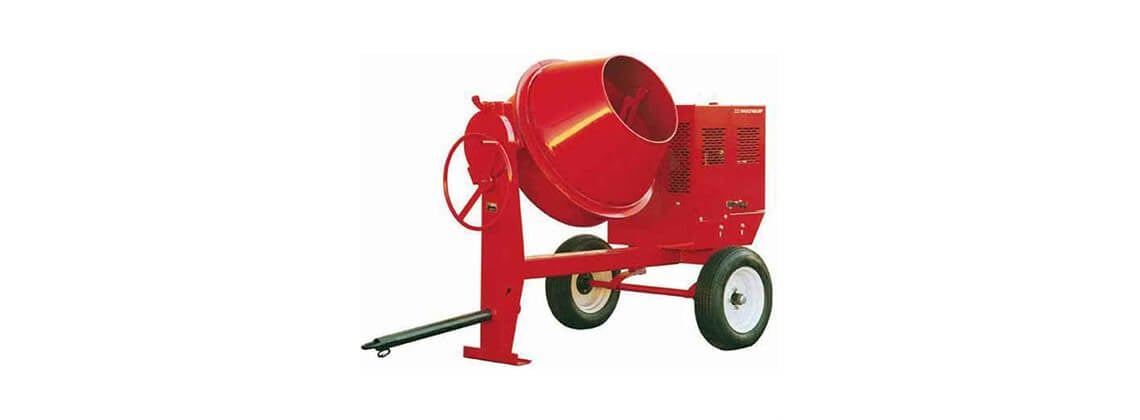
Considering a concrete mixer gas model for your next job? Understandably so, as they offer exceptional power and reliability where an electric supply is unreliable or unavailable. This article will guide you through the advantages of using a gas-powered concrete mixer, detail the key considerations for selection, and showcase the top models to keep your projects moving smoothly and efficiently, no matter the time or location.
Key Takeaways
-
Concrete mixer gas deliver high torque at low speeds, crucial for mixing concrete consistently, and are suitable for remote or outdoor construction sites lacking electricity.
-
High-quality concrete mixer gas are characterized by large drum capacity, durable steel construction for a long service life, and features for enhanced portability and user comfort.
-
Having an in-house concrete mixer gas offers control over production, reduces environmental impact, saves logistics costs, and can provide better long-term savings despite higher initial expenditures.
Understanding Concrete Mixer Gas
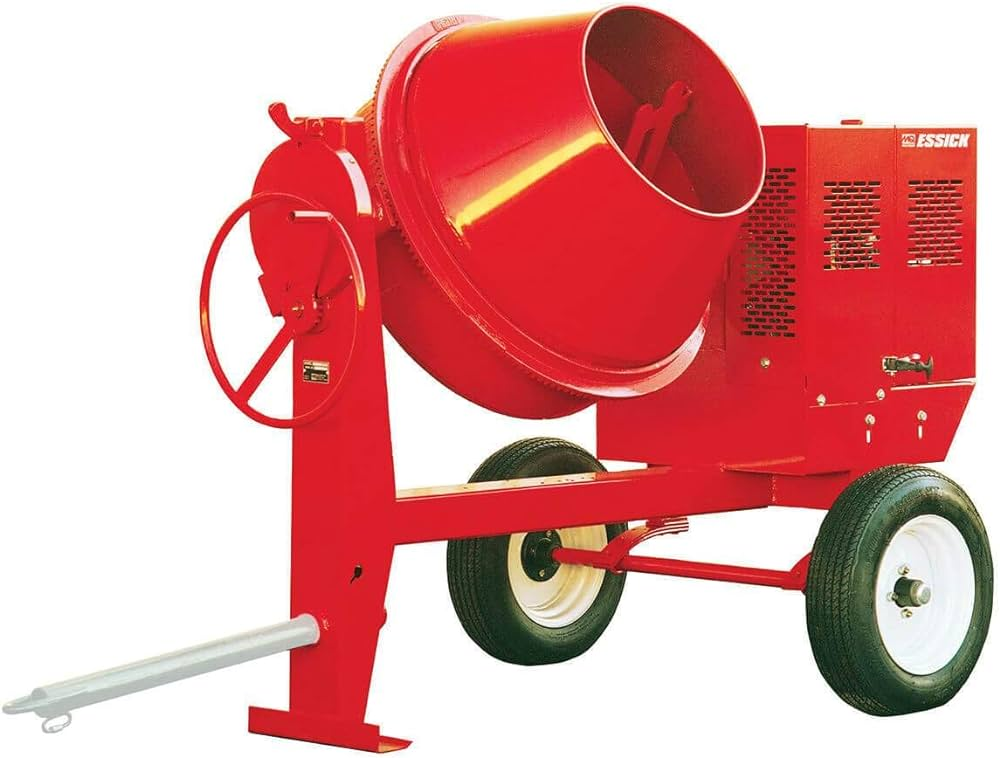
The principle of internal combustion powers gasoline-powered concrete mixers, using the four-stroke cycle to boost mixing performance. This cycle comprises:
-
Intake
-
Compression
-
Power
-
Exhaust
The power stroke is particularly crucial. Here, fuel is injected and ignites, driving the piston down, rotating the crankshaft, and powering the mixing drum. The gasoline engine, therefore, is a powerhouse engine that transforms the chemical energy of fuel into thermal energy, which is then converted into mechanical work to move the mixing drum.
You might wonder, why choose gasoline over traditional electric cement mixers? Well, gasoline engines provide a high torque at low speeds, which is essential for the heavy-duty task of concrete mixing and ensures consistent and thorough mixing of materials. Moreover, gasoline-powered concrete mixers are ideal for construction sites where large volumes of concrete are needed and where electricity might not be readily available, making them highly suitable for remote or outdoor job sites.
The Role of Gasoline in Cement Mixing
Gasoline engines, with their high torque at low speeds, can effortlessly manage the demanding job of concrete mixing, guaranteeing consistent and thorough material blending. This makes gasoline-powered concrete mixers ideal for job sites where large quantities of concrete are needed and where electrical power is not readily available.
The choice between gasoline and electric power for concrete mixers ultimately rests on job site conditions, power supply availability, and whether the mixer will be primarily used to pour, indoors or outdoors. A battery hook can be a handy accessory for electric mixers in situations where power supply is limited.
Selecting the Right Gas Engine
Choosing the suitable gasoline engine for your concrete mixer gas requires an emphasis on power. The engine power of gas-powered concrete mixers, typically gauged in horsepower (HP), plays a crucial role in their performance. Smaller concrete mixers generally require engines in the range of 5 to 10 HP, while larger mixers necessitate more powerful engines.
Also, consider the size of the mixer drum, as a larger drum calls for a more powerful engine to ensure effective operation and efficient fuel usage.
Essential Features of Top-Tier Concrete Mixer Gas
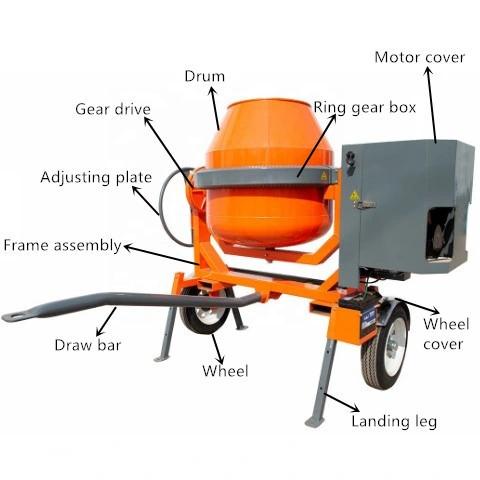
Investing in a concrete mixer with specific features can notably upgrade your operation. High-quality concrete mixers are designed with large drums, allowing you to mix more concrete at once and increase productivity. But size isn’t everything. The inner workings of the drum also matter. Innovative paddling within the drum can yield a more uniform concrete mix, which is crucial for construction quality.
Furthermore, a motor with high horsepower is a crucial feature for concrete mixers, as it supplies the needed power to mix dense concrete ingredients thoroughly. High-grade components and heavy-duty materials, like cast iron and steel, make concrete mixers more robust and less prone to wear over time. The longevity and durability of concrete mixers are primarily determined by their construction quality, underlining the importance of a durable design in top-tier models.
Robust Steel Construction
When it comes to the construction of concrete mixers, steel is king. Renowned brands like Gilson Cement Mixers and Shumaker Industries use robust, high-grade domestic steel in construction, ensuring long-lasting functionality. These mixers are designed with 7-gauge drum shells, 3/16-inch flanged drum heads, and 1 1/2-inch solid-steel square paddles.
This high-grade steel withstands the rigors of intensive concrete mixing and ensures a long service life of the cement mixer itself’s drum.
Drum Capacity and Dimensions
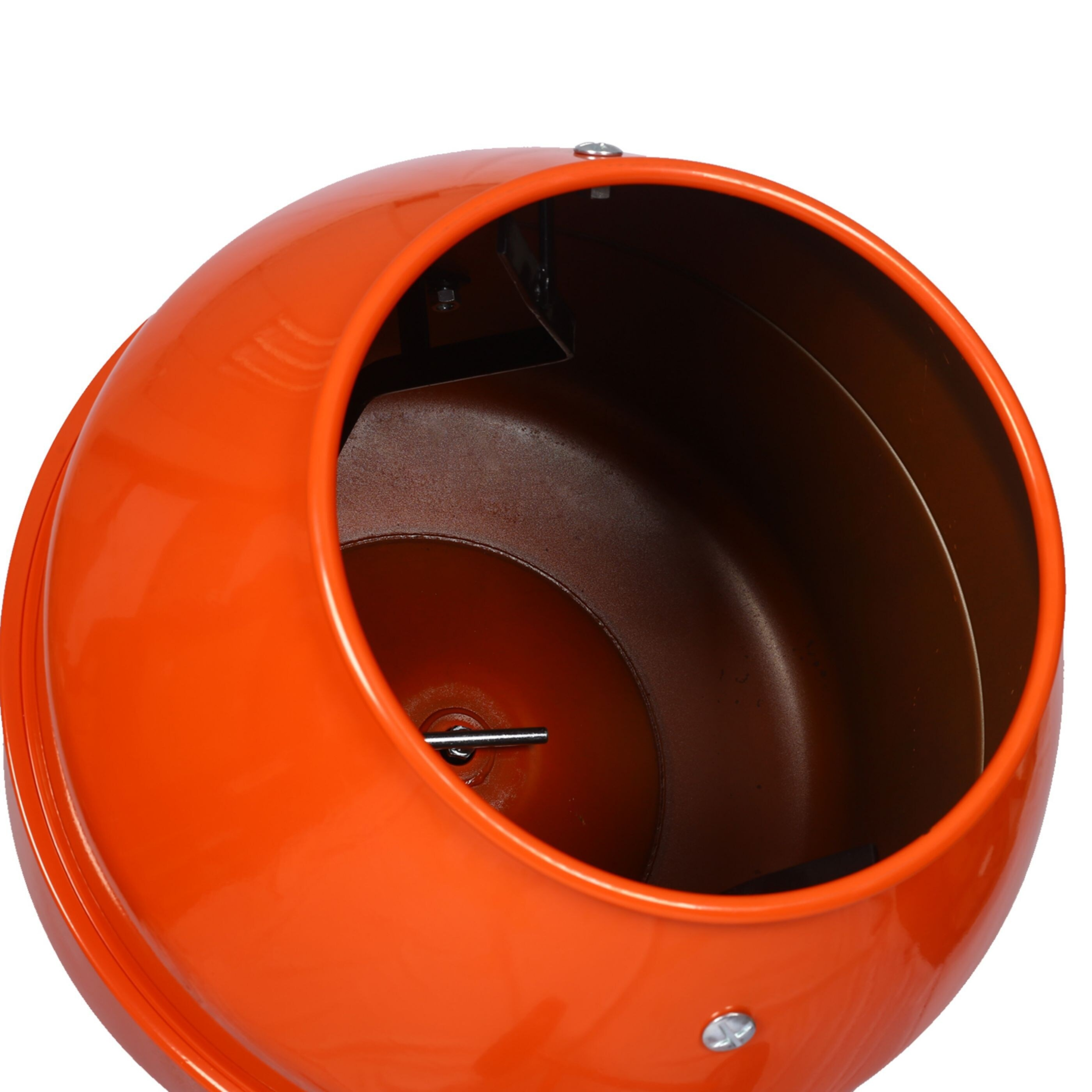
Concrete mixers come in various capacities, typically ranging from 1-1/2 cubic feet to 16 cubic feet, each catering to diverse project requirements. The size of a concrete mixer determines the achievable volume per batch. For instance, smaller mixers produce about 200 pounds (1-1/3 cubic feet) while larger mixers manage up to 1100 pounds (7-1/3 to 9 cubic- feet).
However, mixers within the 6 to 9 cubic feet capacity are particularly popular tools, given their ability to handle batch sizes from just under 300 pounds to nearly 500 pounds, suitable for various job scales and readily available in stock.
Mixer Portability and Job Site Mobility
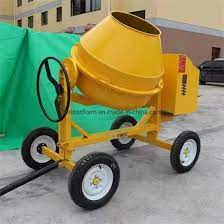
In the dynamic environment of a construction site, the ease of transport and maneuverability of a concrete mixer can significantly impact productivity and efficiency. A concrete mixer with easy transport and maneuverability on the job site can significantly cut down labor time and related moving expenses. For instance, the Hand-Tow Portable Concrete Mixer model is specially designed for easy transport, facilitating mobility for multiple projects.
Apart from portability, the design of a concrete mixer can also improve its usability. Mixers like the YARDMAX 4.0 Cu. Ft. model have a drum positioned at chest height with long handles, improving the ease of loading and unloading materials. Furthermore, mixers designed with a wide base offer increased stability both during operation and transit on the job site.
Ergonomic features such as adjustable handles, control positions, padded seating, and user-friendly controls improve the ships and operation comfort at job sites, making them essential tools.
The Advantages of Stocking Your Own Concrete Mixer Gas
Producing concrete mixer gas in-house can provide numerous benefits compared to outsourcing. One of the most significant benefits is the control you have over the quantity of stock the product, enabling efficient resource planning and the ability to meet demand without delay. Stocking a concrete mixer on-site enables immediate response to project demands, increasing overall efficiency and productivity of construction operations.
Moreover, having an in-house concrete mixer gas can offer several benefits, including:
-
Significantly reducing the environmental impact of your operations by minimizing waste and optimizing the use of materials
-
Saving resources in terms of logistics, as transportation costs are reduced and the risks of quality compromise during long-distance transit are eliminated
-
Potential cost savings over time, as businesses avoid the markup prices that come with purchasing ready-mixed concrete from external suppliers.
How to Ensure Optimal Mixing with Your Concrete Mixer Gas
Creating the perfect concrete mix gas is akin to an art rather than a science. Here’s how to do it:
-
Start by loading one-third to one-half of the required water into the mixer.
-
Add one-eighth to one-fourth of the dry mix in an alternating fashion until all materials are added. This method ensures even mixing and helps manage consistency.
-
Remember to measure water precisely and initiate mixing by pouring three-quarters of the pre-measured water into the mixer before adding the mix.
To reduce dust and control consistency during mixing, cover the mixer’s opening, mix for 3 minutes, and gradually add the remaining water. The mixer’s size is also critical; standard mixers typically handle two 80-pound bags of concrete per batch to avoid premature curing inside the mixer. Lastly, remember that each per mortar batch should be mixed for approximately 5 minutes, allowing for up to 12 rounds within the one-hour window.
Price Considerations When Choosing Your Concrete Mixer
Several factors can affect the price of a concrete mixer. The size and capacity of a concrete mixer are directly proportional to its price, with larger mixers usually costing more due to their higher production capacity. Advanced features such as computerized controls and improved hydraulic systems can significantly increase the price of a concrete mixer, while also potentially improving efficiency.
The manufacturer’s brand reputation often influences the price of a concrete mixer, with more established brands usually having higher prices. However, it’s important to consider the longevity and reliability of a concrete mixer, as well as items such as the availability of spare parts and after-sales service, which may imply a higher initial price but better long-term value. Performing extensive research and comparing options are key to finding a reliable and cost-effective concrete mixer that fits one’s budget and requirements.
Review: Top-Rated Gas-Powered Concrete Mixers
There are several top-rated gas-powered concrete mixers on the market, each with its unique features and benefits. Some of the best options include:
-
Central Machinery’s mixer, noted for its durable steel construction
-
Kushlan mixer, featuring a polyethylene drum resistant to cracks, dents, and rust
-
Yardmax’s 5 cubic feet mixer, suitable for smaller project sizes
-
IMER Wheelman II’s versatile 5 cubic feet option
These mixers offer various capacities suited for different project sizes and dimensions, making it easy to pour the right amount of material.
Features of different mixers include:
-
Cleanable barrel and breakdown for storage in Kushlan’s 350 DD
-
Easy assembly and smooth job site movement of the Ryobi portable mixer
-
Customization options for engines and towing in the Marshalltown 600CM
-
Balance of capability with portability and durability in the Kobalt mixer
Security Measures for Operating Gasoline Concrete Mixers
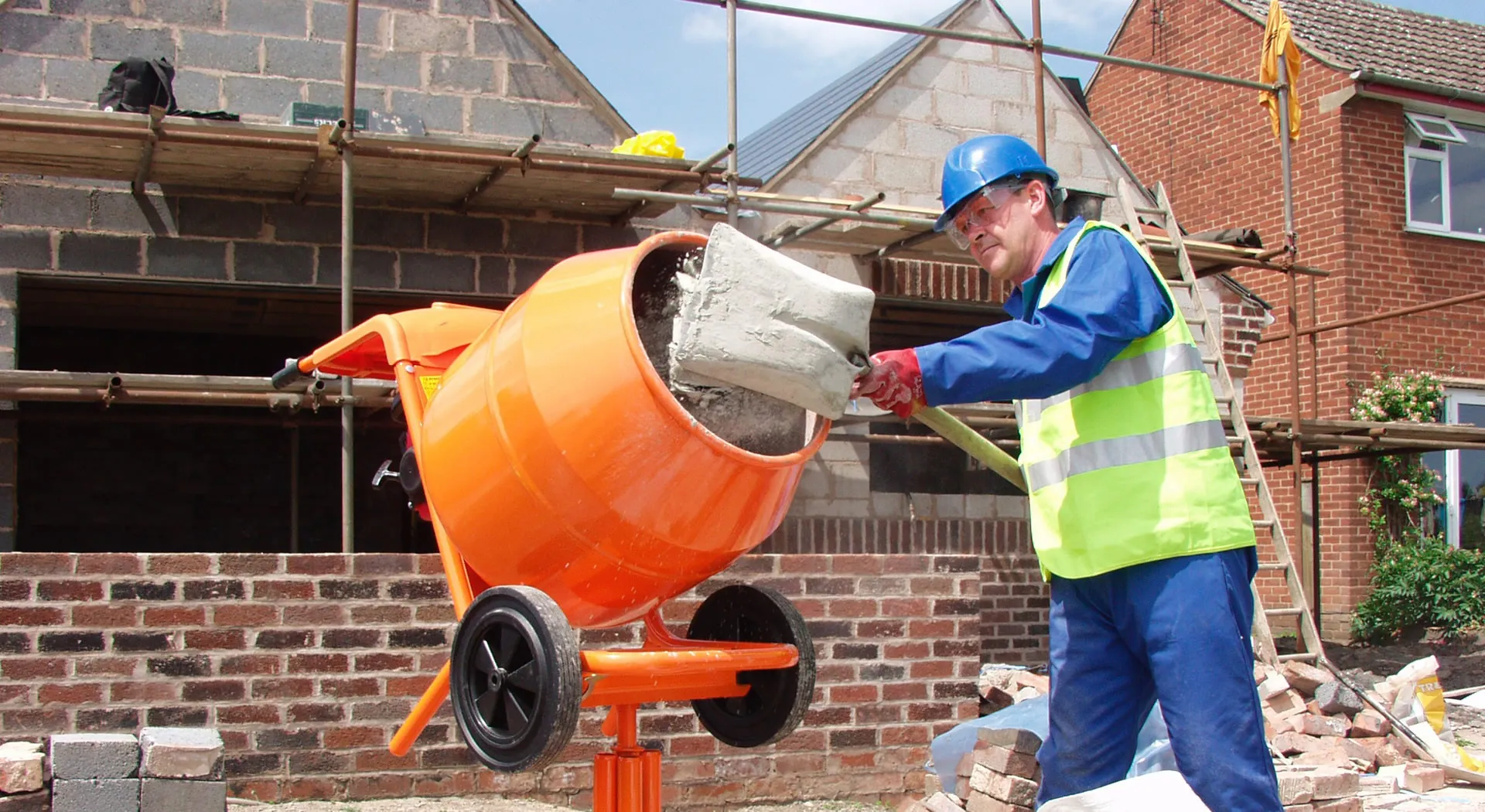
Several safety measures are necessary when operating a gasoline concrete mixer to safeguard the operator and surrounding individuals. For instance, it’s important to protect all mobile parts of the concrete mixer with casings to prevent injuries from moving elements such as gears and belts. Additionally, equipping the drum with a tipping brake can control drum movement, preventing accidental release of materials or rapid movement that could cause injury.
Operators should follow these safety guidelines when using a mixer:
-
Never insert hands or a shovel into a rotating drum to avoid entrapment and injury.
-
After use, immobilize the mixer with its dedicated mechanism to prevent inadvertent operation or movement.
-
Wear safety helmets, anti-dust safety goggles, rubber or PVC gloves, and waterproof suits for personal protection.
Regular inspections of the mixer’s components, safety devices, and general condition, as well as maintaining cleanliness and lubrication of moving parts, are also crucial for safe operation.
Ordering Your Concrete Mixer: Steps to Take
You can order a concrete mixer in a few simple steps. Begin by browsing the online selection of concrete mixers, exploring various categories including accessories, handheld concrete mixers,, mixing paddles, mortar mixers, and parts. Consider concrete mixers from reputable brands such as Bartell, Imer, Multiquip, or Crown Construction Equipment based on your preference.
Once you’ve selected a concrete mixer that aligns with your budget and meets your performance requirements, follow these easy steps to complete your order:
-
Add the concrete mixer to your cart.
-
Proceed to the checkout.
-
Provide your payment details.
-
Confirm the order.
-
Prepare to arrange for shipment to your desired address.
-
During checkout, furnish the necessary shipping details.
-
Choose a delivery option that accommodates your schedule and location requirements.
Summary
In conclusion, gasoline-powered concrete mixers offer numerous advantages in terms of efficiency, performance, and convenience. Whether you’re a seasoned construction professional or a DIY enthusiast, an understanding of the internal workings of these mixers, the crucial role of gasoline in cement mixing, and the key features to look out for when purchasing one can significantly enhance your productivity. By choosing the right engine, drum capacity, and security measures, you can ensure optimal mixing, cost savings, and safety in your concrete mixing operations.
Certified MTP offers a full line of Cement Mixers, Stationary Cement Mixers, Concrete Mixers, Concrete Cement Mixers, Cement Mixer Tubs, Concrete Mixer Drill, and Portable Concrete Mixers.
Frequently Asked Questions
Why should I choose a gasoline-powered concrete mixer?
You should choose a gasoline-powered concrete mixer for its high torque at low speeds, making it ideal for heavy-duty concrete mixing tasks, especially in remote or outdoor job sites without ready access to electricity.
What are the key features to look out for in a top-tier concrete mixer?
The key features to look for in a top-tier concrete mixer are a large mixing drum, innovative paddling, a high horse-powered motor, and high-grade components for durability. These features contribute to increased productivity and a uniform mix.
What are the advantages of having an in-house concrete mixer?
Having an in-house concrete mixer provides control over quantity, immediate response to project demands, reduces environmental impact, saves on logistics costs, and leads to long-term cost savings. This can be a valuable asset for your construction projects.
How can I ensure optimal mixing with my concrete mixer?
To ensure optimal mixing with your concrete mixer, load water and dry mix alternately, measure water and mix precisely, cover the mixer’s opening during mixing, and mix each batch for about 5 minutes.
What factors influence the price of a concrete mixer?
The price of a concrete mixer is influenced by factors such as size, capacity, advanced features, brand reputation, and market demand. These factors play a significant role in determining the cost and price of the equipment.
Related Blogs for Concrete Mixer Gas:
Concrete Mixer Trailer: Get Ready For Your Project
Top Durable Concrete Drum Options for Efficient Mixing
Best Portable Concrete Mixers of 2024: Mixing Mastery
Best Cart Away Mixer for Your Construction Needs
Concrete Mixer Large: Maximize Mix for Construction Projects
Cement Mixer Tub Options for Efficient Concrete Preparation
Gilson Cement Mixers: Durable Solutions for Concrete Mixing
Mixer for Concrete: The Ultimate Guide to Choosing
Hand Mixer for Concrete: Your Tool for Cement Mixing
How a Drill Mixer Can Streamline Your DIY Projects
Best Cement Mixer Gas Motor Options on the Market
We recommend the Stationary Concrete Mixer for most residential and small construction projects.
